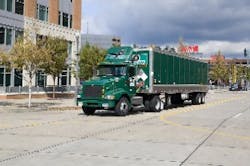Recently, LTL carrier New Penn celebrated the achievement of one million miles driven without a preventable accident by 21 of its drivers and gave props to two others - Keith Degler of Reading, PA, and Michael Swingle of Scranton, PA - for reaching the two-million mile safe driving mark: truly astounding accomplishments all the way around.
I mean, one million miles is about equal to driving around the world at its widest point - the equator - about 40 times, meaning Degler and Swingle did that 80 times. (Just think if they‘d racked up that mileage in a commercial jetliner! They‘d have free airline tickets for a lifetime and then some!)
“We are all extremely proud of our skilled drivers for their outstanding achievement. They exemplify the engagement and pride essential to make our highways safe while meeting our customers‘ needs,” said Steven Gast, president and CEO of Lebanon, PA-based New Penn, which is a subsidiary of transportation conglomerate YRC Worldwide, which is headquartered in Overland Park, KS.
That comment, taken from New Penn‘s press release announcing their drivers‘ achievements, is expected - if not demanded - from a trucking executive, for safe driving of this extraordinary caliber is absolutely vital to carriers, knowing how crowded the highways are these days.
But what do million-mile safety records really mean? What‘s its true value to a carrier, much less the general public?
I talked to Andy Kerlik, vice president of safety at New Penn, about this and he told me that while million-mile safety records are a big deal internally, they usually fall on deaf ears outside the trucking community. “We advertise these records both internally and externally. But it really has the most value internally to us and our driver corps,” he told me. “While we broadcast these achievements outside our company, they are just not recognized by the public. It‘s the same old story: good news doesn‘t make the paper, especially when it comes to big trucks.”
Kerlik‘s been at New Penn for close to 36 years now, with the safety department since 1981, and has watched the company go from a $12 million a year carrier to one garnering $300 million annually in revenue - all without compromising safety one iota. “We have it easier, in many ways, because as an LTL we have very little turnover,” he said. “Our guys are driving set routes and are home almost every night. And it‘s a lot easier to build up a focus on safety when you know a driver is going to be with you for decade, instead of seeing new faces every couple of weeks or months.”
And safety is a big deal at new Penn - like at most carriers - because it recognizes safety is integrally tied into revenues and profits. “One hand feeds the other,” Kerlik explained to me. “Good drivers plus good equipment plus good safety adds up to good operating results.”
And it‘s not just about driving skills completely anymore, either, Kerlik said: attitude and physical well-being are key components in the mix as well. “Our best drivers are calm people, because they know driving on the highway can be extremely difficult with all the rudeness and road rage out there,” he said. “More and more of them are also getting into physical fitness as they realize that has an impact on their capability behind the wheel. And they love what they do - most of our successful drivers really love driving trucks. That really ties them into the profession in a positive way.”
On a final note, Kerlik stressed that New Penn doesn‘t wait to give praise to drivers until they compile stratospheric numbers like a million miles - that‘s a career‘s worth of driving. The company strives to recognize safety accomplishments on a yearly basis, awarding watches, rings, jackets and other goodies to mark those achievements in a very public way among its drivers.
“You‘ve got to have near-term goals most everyone can achieve,” Kerlik said. “And that means looking at both the positive and the negative. I‘ve got three safety supervisors that go out in the field every day making sure our drivers are doing their best, going on check rides with them, etc. Safety is in constant focus here.”
